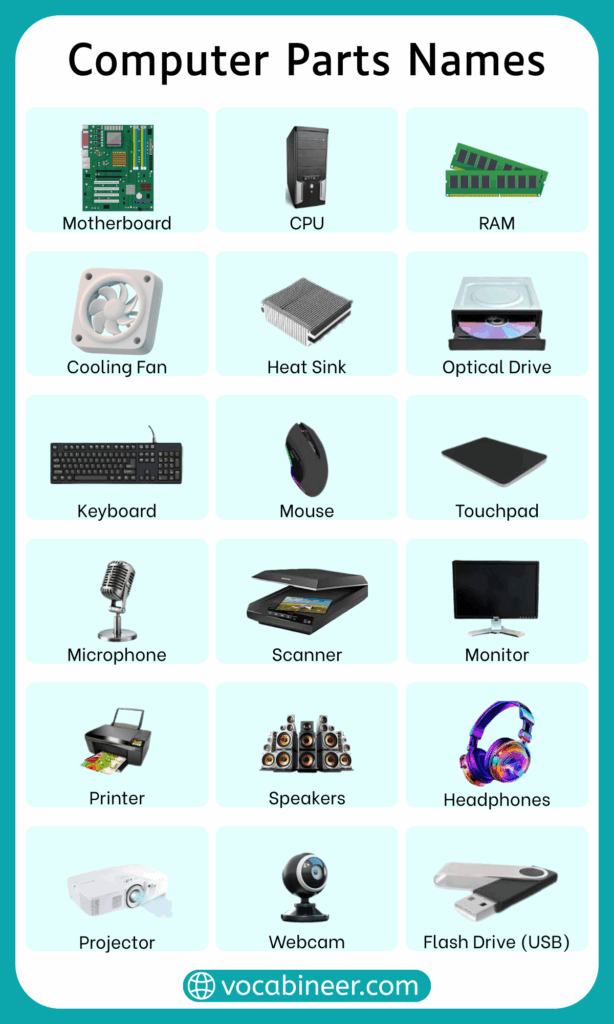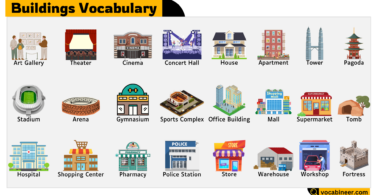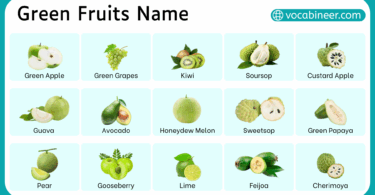The parts of a computer have names that tell us what each hardware piece is and how it works. Every part has a defined role, from the processor and memory to input and output devices that connect the system together. In this post, you’ll learn computer part names with their functions explained in English. Readers can understand them better through pictures included here.
In This Page
What is a Computer?
A computer is a machine that takes information, works on it, and gives back results. It follows instructions step by step to finish tasks. Computers can solve math problems, play music, show videos, and run games. They have hardware you can touch and software that gives commands. You can find computers as desktops, laptops, tablets, or even phones. All computers take input, process it, store it, and give output.
List of Computer Parts and Their Functions
Every computer part has its own job. Together, they make the system work smoothly by handling input, processing, storage, and output.
- CPU: Runs instructions and controls other parts so the computer can complete tasks.
- Motherboard: Connects all parts together and lets them communicate with each other.
- RAM: Stores temporary data and helps run multiple programs at the same time.
- ROM: Holds permanent instructions so the computer can start up properly.
- Storage Drives: Save files, programs, and the operating system for long-term use.
- Power Supply: Provides electricity to all the parts inside the computer.
- Keyboard: Lets users type letters, numbers, and commands.
- Mouse: Moves the pointer and selects items on the screen.
- Monitor: Displays images, text, and videos created by the computer.
- Printer: Produces paper copies of documents and pictures.
- Speakers: Play sound such as voices, music, or alerts.
- Microphone: Records voice and sends it into the computer.
- GPU: Handles graphics and improves the quality of images and videos.
- Cooling Fans: Keep the inside of the computer cool and prevent overheating.
- Network Card: Connects the computer to the internet or local networks.
- Sound Card: Improves sound quality and supports audio devices like headphones or microphones.

For more , you may also enjoy our guide on Types of Fast Food.
Main Parts of a Computer
Computers rely on a few essential components that handle the most important work. Without these parts, the machine cannot function at all.
- CPU: Known as the brain of the computer, it processes instructions, calculations, and commands given by software programs.
- Motherboard: A large circuit board that holds and connects the CPU, memory, storage, and all other hardware parts.
- RAM: A temporary memory unit that lets you run multiple tasks quickly without slowing down the computer.
- Storage Drives: Devices like HDD and SSD that permanently keep files, applications, and the operating system safe for later use.
- Power Supply: Converts electricity from the wall socket into the right voltage for each internal component.
Internal Parts of a Computer
Inside a computer case are important pieces that you cannot always see. These parts make the machine work faster, cooler, and more connected.
- GPU: A graphics processor that handles images, videos, and games, giving clear visuals on the monitor.
- Cooling Fans: Small spinning devices that move air inside the case to keep parts from overheating.
- Network Card: A small board that lets the computer connect to the internet or other networks.
- Sound Card: Improves audio quality and connects headphones, microphones, or speakers for better sound.
- BIOS/CMOS Battery: A coin-shaped battery that saves basic startup settings even when the power is off.
- ROM: A chip that stores permanent instructions so the computer can turn on properly every time.
Input Devices of a Computer
Input devices let people send information into the computer. These parts make it possible to type, click, speak, or scan data.
- Keyboard: A board with alphabet, number, and function keys that helps you type words, numbers, and commands.
- Mouse: A handheld device with buttons and a sensor that moves the pointer and selects things on the screen.
- Microphone: Captures your voice and changes it into signals the computer can understand for recording or calls.
- Scanner: Copies papers, photos, or drawings and saves them as digital files inside the computer.
- Touchpad: A flat surface on laptops that lets you move the pointer and click by using your fingers.
- Webcam: A small built-in or external camera that records or streams live video directly to the computer.
Output Devices of a Computer
Output devices let the computer share information back with the user. They make results visible, printable, or audible after processing data.
- Monitor: A screen that displays text, images, and videos so you can see what the computer is doing.
- Printer: A machine that produces paper copies of documents, assignments, or photos stored in the computer.
- Speakers: Devices that play sounds, music, and voices produced by the computer’s software or media files.
- Projector: Shows enlarged visuals on a wall or screen, useful in classrooms, meetings, or home theaters.
- Headphones: Worn over the ears to listen to sound privately without disturbing others nearby.
Computer Types and Their Parts
Computers come in different forms, but all of them share common parts. Each type also has a few unique features.
- Desktop Computer Parts: Includes a tower case, monitor, keyboard, and mouse. It is common in schools, homes, and offices.
- Laptop Computer Parts: Has a built-in screen, keyboard, touchpad, webcam, and a rechargeable battery for portable use.
- Notebook Computer Parts: Smaller and lighter than laptops, with similar parts but usually less powerful in performance.
- Gaming Computer Parts: Features a strong GPU, advanced cooling system, extra RAM, and fast storage for smooth gaming.
- Personal Computer Parts: A general system with CPU, RAM, storage, monitor, keyboard, and mouse used in homes and workplaces.
FAQs on Parts of a Computer
The CPU (Central Processing Unit) acts like the brain of the computer. It reads instructions from software, performs calculations, and controls other parts so applications can run properly.
RAM holds data temporarily while the computer is working on tasks. Storage Drives (like HDD or SSD) keep data permanently—files, photos, or programs—even when the power is off.
Cooling Fans help move air inside the computer to remove heat from components like CPU or GPU. They prevent overheating which can slow performance or damage internal parts.
Input devices send data into the computer (for example Keyboard, Mouse, Microphone). Output devices show, print, or play results, such as Monitor, Printer, or Speakers.
The Motherboard is the main circuit board that connects CPU, RAM, GPU, power supply, and other parts. It allows these components to communicate and work together as one system.
Read More




